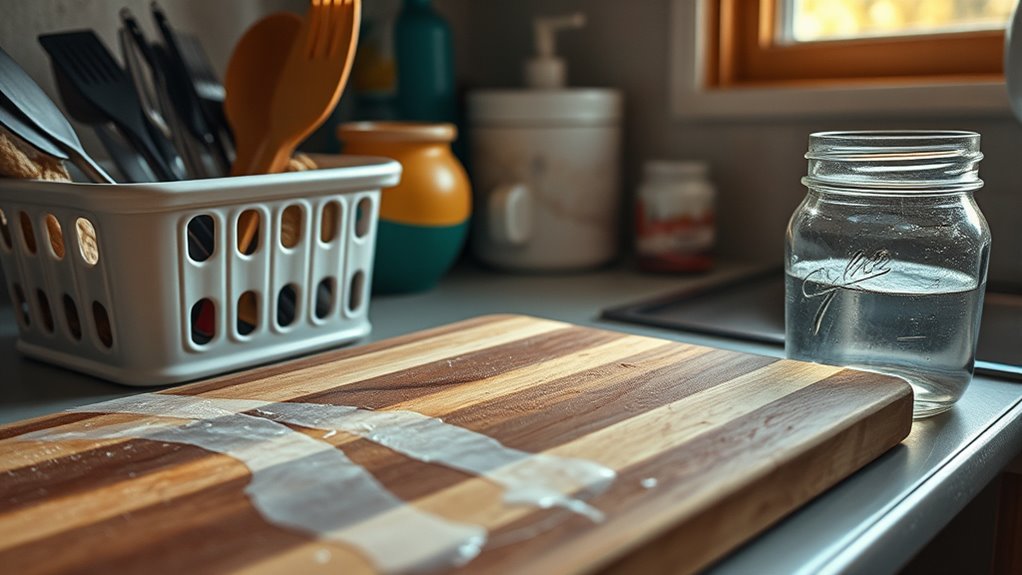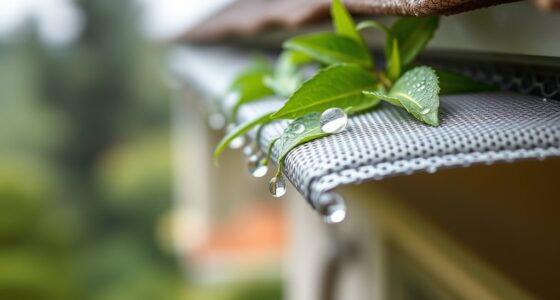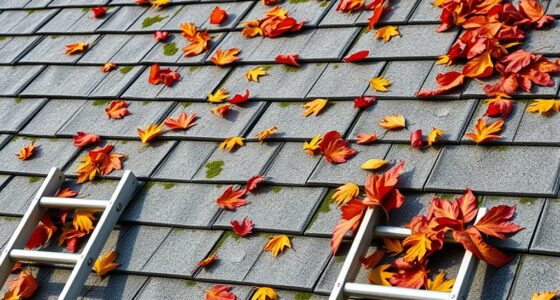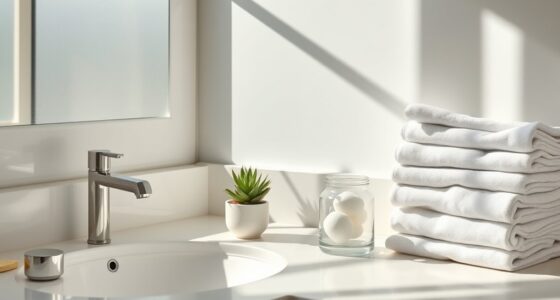The one thing you’re likely cleaning wrong in your home is using harsh chemicals or abrasive tools on delicate surfaces like glass, wood, or electronics. These rough methods cause micro-scratches, discoloration, or damage that’s hard to see at first but worsens over time. Instead, gentle cleaners, soft cloths, and proper techniques protect your surfaces and keep them lasting longer. Want to discover simple tweaks that prevent damage and promote a healthier home? Keep exploring to learn more.
Key Takeaways
- Using abrasive tools like steel wool on delicate surfaces causes micro-scratches and long-term damage.
- Spraying cleaners directly onto screens or glass can lead to streaks and residue buildup.
- Overusing harsh chemicals weakens surfaces and increases health and environmental risks.
- Neglecting to regularly clean and dry sponge tools promotes bacterial growth and spread of germs.
- Cleaning with excessive force or improper techniques can damage wood finishes and paint.
The Hidden Damage of Using the Wrong Cleaning Tools
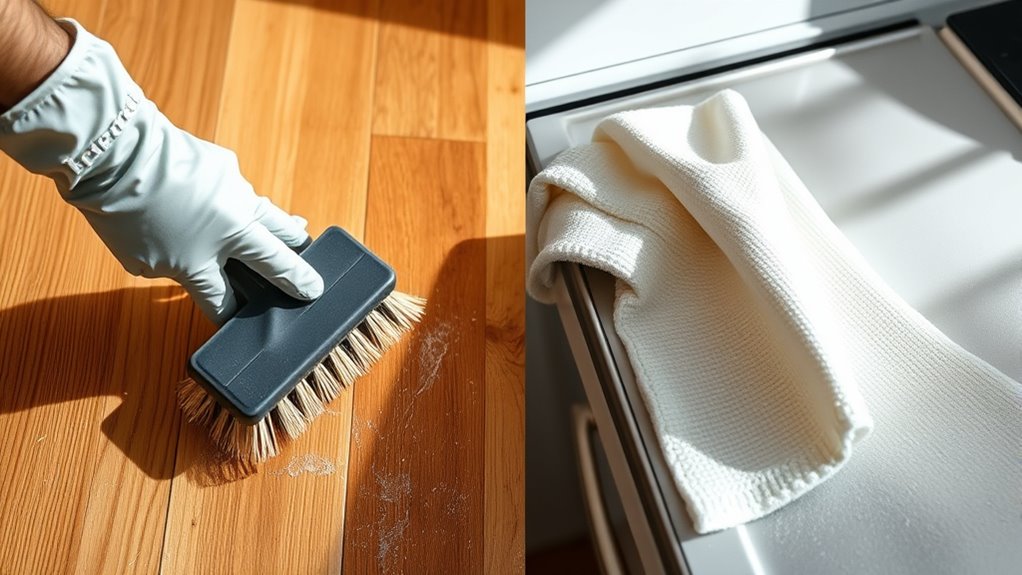
Using the wrong cleaning tools might seem harmless, but it can actually cause hidden damage to your home surfaces. For example, abrasive scrub brushes or steel wool can scratch delicate surfaces like glass, ceramic, or wood. Using a rough brush on a soft countertop can leave micro-scratches that weaken the material over time. Even microfiber cloths or sponges, if not used properly, can spread dirt and grime instead of removing them, leading to buildup that’s hard to see. These mistakes might not be immediately obvious, but they can compromise the appearance and integrity of your surfaces. Choosing the correct cleaning tools for each task is essential to prevent this hidden damage, ensuring your home stays beautiful and well-maintained without unintended harm. Proper cleaning techniques also play a crucial role in preserving your surfaces over time.
Why Overusing Harsh Chemicals Can Backfire
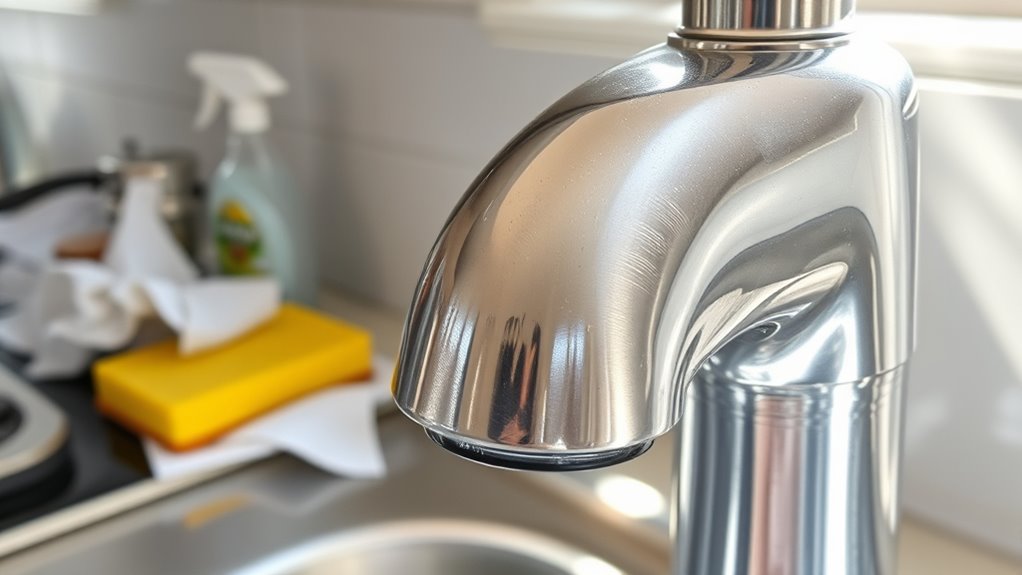
While harsh chemicals may seem like the quickest way to clean, overusing them can actually do more harm than good. Excessive chemical use triggers unintended chemical reactions that can damage surfaces and pose health risks. These strong substances can weaken materials over time, leading to costly repairs or replacements. Additionally, harsh chemicals often have a significant environmental impact, contaminating water sources and harming wildlife. When you rely too heavily on these cleaners, you may also create residues that are difficult to remove and potentially toxic. Furthermore, proper cleaning techniques and the use of eco-friendly products can help you maintain a healthier home environment without the risks associated with harsh chemicals. Moderation and proper product selection can help you achieve a cleaner home without the unintended consequences of overusing harsh chemicals.
The Correct Way to Clean Your Glass Surfaces

Cleaning your glass surfaces properly guarantees they stay streak-free and clear, but it’s easy to make mistakes that leave smudges or cause damage. To achieve glass clarity and a streak-free shine, start by using a soft microfiber cloth instead of paper towels, which can leave lint. Spray a mixture of equal parts water and white vinegar or a dedicated glass cleaner onto the surface, avoiding excess moisture. Wipe gently in a circular motion to prevent streaks. Use a dry, clean cloth to buff the glass, enhancing clarity. Avoid harsh chemicals or abrasive tools, as they can scratch or etch the surface. Regular cleaning with the right techniques can also help maintain the air quality in your home, as dust and pollutants can settle on surfaces and impact overall air cleanliness. With these simple steps, you’ll ensure your glass surfaces remain spotless, glossy, and truly streak-free.
How to Properly Maintain Wooden Furniture
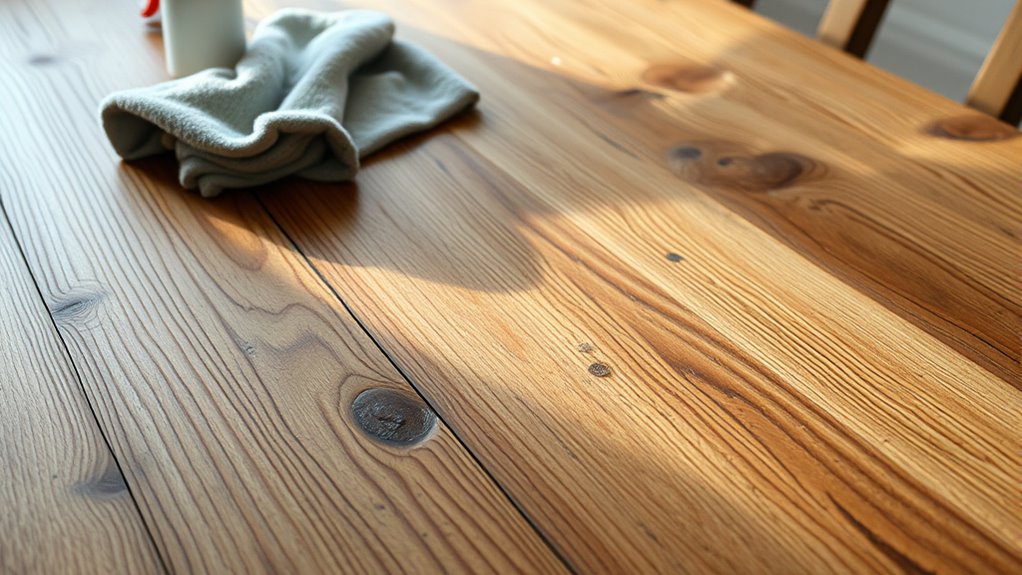
To keep your wooden furniture looking its best, use gentle cleaners that won’t damage the surface. Establish a regular polishing routine to restore shine and protect the wood. Consistent care makes your furniture last longer and retains its natural beauty. Incorporating automation technologies into your maintenance routine can also help ensure consistent and effective care over time.
Use Gentle Cleaners
Have you ever wondered why harsh chemicals can damage your wooden furniture? Using gentle cleaners is essential to preserve its finish and longevity. Instead of strong chemicals, opt for eco-friendly products designed for wood. Imagine this:
- Soft, damp cloths gliding smoothly over the surface
- Mild soap diluted in water, creating a gentle cleaning solution
- Natural oils or beeswax for conditioning, not stripping the wood’s natural sheen
- Being aware of AI safety concerns helps ensure that cleaning tools and smart home devices integrated into your routine remain secure and trustworthy.
These simple steps help maintain the wood’s beauty without risking damage. Gentle cleaning prevents residue buildup and keeps your furniture looking new. By choosing eco-friendly products, you’re not only protecting your furniture but also reducing chemical exposure in your home. Remember, less harshness means longer-lasting, healthier wooden furniture.
Regular Polishing Routine
Regular polishing is key to preserving your wooden furniture’s luster and protecting it from wear. You should polish your furniture every few months, depending on use and environment, to maintain surface protection. Over-polishing can create a sticky buildup, while infrequent polishing allows dust and grime to settle, dulling the finish. Use a high-quality polish suitable for wood and apply it with a soft cloth, working in the direction of the grain. Be gentle and avoid excessive rubbing, which can damage the finish. Regular polishing not only enhances the appearance but also forms a protective barrier against moisture and scratches. Consistent maintenance ensures your furniture remains beautiful and durable for years to come, preventing the need for costly repairs or refinishing down the line. Additionally, understanding proper Louisiana alimony laws can help you navigate financial responsibilities after maintaining your furniture.
The Mistake That Spreads Germs on Kitchen Sponges
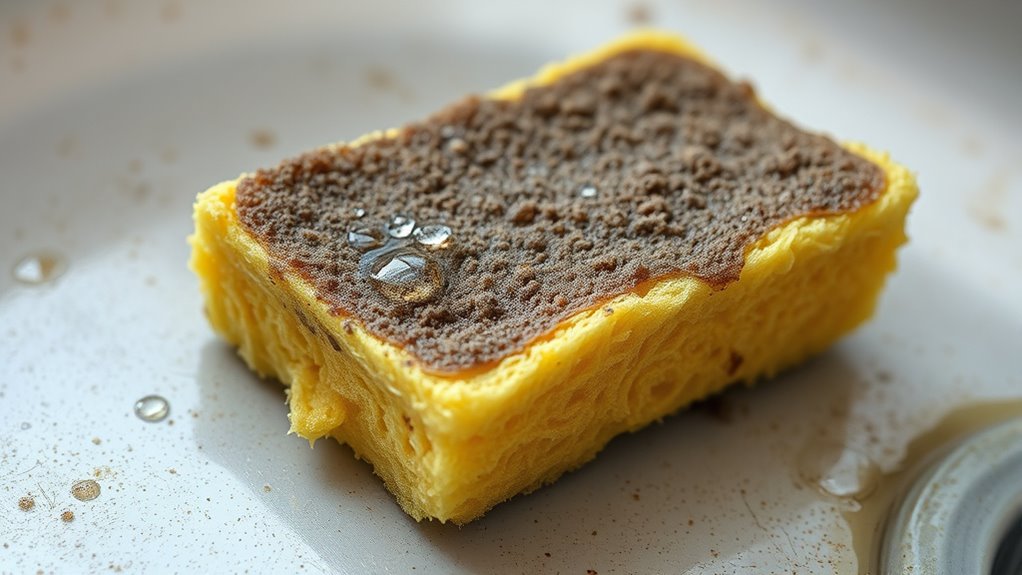
Many people leave their kitchen sponges damp, creating a perfect environment for germs to grow. Using harsh cleaners on your sponge can also push bacteria further into its pores, making it harder to disinfect. Proper drying and gentle cleaning are key to preventing the spread of germs from your sponge. Implementing proper cleaning techniques can further reduce bacterial buildup on your sponge.
Improper Sponge Drying
When you leave your kitchen sponge to air dry in a damp environment, you create an ideal breeding ground for germs. Poor sponge storage and drying habits allow bacteria to thrive. Imagine:
- A soggy sponge sitting in a dark, closed sponge holder overnight.
- Water lingering in crevices, encouraging mold growth.
- Stale moisture turning your sponge into a germ hotspot.
Additionally, using proper vacuum cleaner attachments like a dusting brush or crevice tool can help you clean surrounding surfaces more effectively, reducing overall germs in your kitchen.
Instead, squeeze out excess water thoroughly after use. Store your sponge in a well-ventilated area, preferably upright, to promote quick drying. Avoid leaving it in damp sponge holders or on the sink where moisture lingers. Proper drying habits reduce bacteria buildup and keep your sponge cleaner longer. Remember, how you dry and store your sponge directly impacts its hygiene and your kitchen’s cleanliness.
Using Harsh Cleaners
Using harsh cleaners on your kitchen sponge might seem effective at killing germs, but in reality, these strong chemicals can create more problems. They cause chemical damage to the sponge’s material, weakening its structure over time. This surface degradation makes the sponge less effective at cleaning and more prone to harboring bacteria. Instead of disinfecting, harsh cleaners can leave residues that promote microbial growth, spreading germs rather than eliminating them. Frequent use of strong chemicals may also damage surrounding surfaces, leading to costly repairs. To keep your sponge sanitary without risking chemical damage, opt for natural disinfectants like vinegar or bleach solutions, and replace sponges regularly. Proper tuning techniques and regular sponge replacement can help maintain both your sponge’s integrity and your kitchen’s hygiene.
The Right Technique for Cleaning Electronic Screens
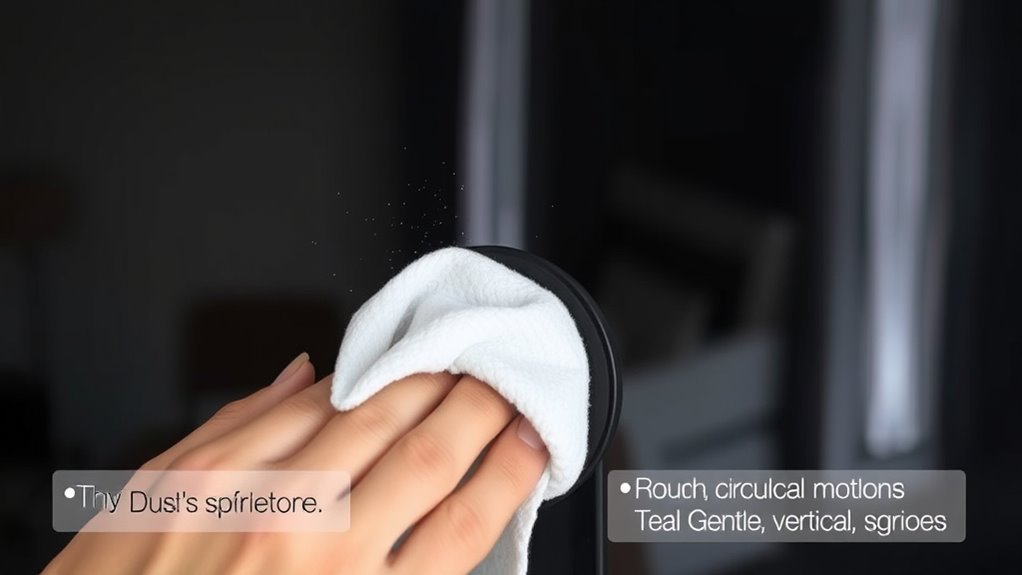
To effectively clean electronic screens without causing damage, you need to follow a careful technique. First, turn off your device and unplug it to avoid electrical issues. Next, grab a clean, dry microfiber cloth—these are best for removing screen smudges without scratching. Gently wipe the screen in a circular motion, avoiding excessive pressure. Here’s what to keep in mind:
- Use a lightly dampened microfiber cloth—never spray cleaner directly on the screen.
- Wipe gently, focusing on smudges and fingerprints.
- Dry the screen with a clean section of the cloth to prevent streaks and residue.
- Regular cleaning can help maintain the indoor air quality around your devices, especially in environments prone to dust and pollutants.
This method guarantees your screen stays clear and undamaged, preserving its clarity and longevity.
Common Dryer Cleaning Errors That Reduce Efficiency
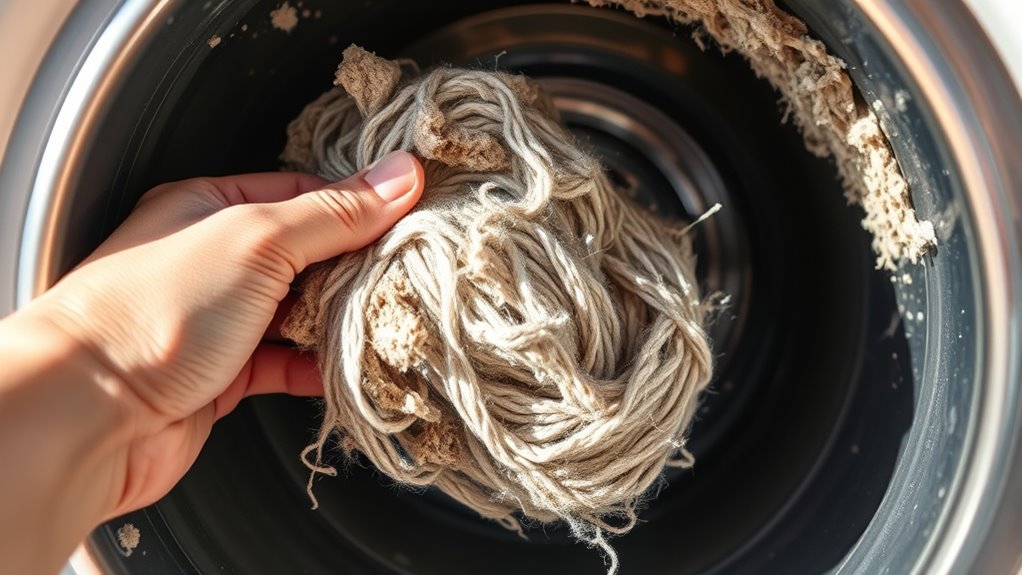
Many homeowners make common mistakes when cleaning their dryer that can decrease its efficiency over time. Ignoring lint traps or neglecting dryer vents leads to longer drying cycles and higher energy bills. Cleaning lint traps only occasionally allows lint buildup inside the ductwork, restricting airflow. Failing to remove lint from the vent can cause overheating and even fires.
| Mistake | Consequence |
|---|---|
| Not cleaning lint traps regularly | Longer drying times |
| Ignoring dryer vents | Reduced airflow, fire risk |
| Using harsh chemicals | Damage to components |
| Cleaning only externally | Internal lint buildup |
| Forgetting to inspect ducts | Increased energy use |
Avoid these errors to keep your dryer running efficiently and safely, saving you money and preventing hazards.
The Best Methods to Keep Your Bathroom Mold-Free

Keeping your bathroom mold-free requires proactive steps to control moisture and prevent mold growth before it starts. Effective mold prevention depends on consistent bathroom ventilation and moisture management. Here are the best methods to achieve this:
Proactively control moisture with ventilation and regular cleaning to prevent bathroom mold growth.
- Install or improve exhaust fans to ensure continuous airflow during and after showers.
- Wipe down wet surfaces like tiles and sinks daily to reduce moisture buildup.
- Use a dehumidifier or open windows regularly to lower humidity levels.
These actions help eliminate excess moisture, making your bathroom less inviting for mold. Regular cleaning with mold-inhibiting solutions further protects surfaces. Prioritizing bathroom ventilation is key to stopping mold from taking hold and maintaining a healthier space.
Frequently Asked Questions
How Often Should I Replace My Cleaning Tools for Optimal Hygiene?
You should replace your cleaning tools regularly to maintain proper cleaning frequency and guarantee tool longevity. Sponges and scrub brushes need replacing every 2-4 weeks, while microfiber cloths can last longer if washed properly. Vacuum bags or filters should be changed every few months, depending on use. Regularly updating your tools prevents bacteria buildup, keeps your home hygienic, and ensures you’re cleaning effectively without spreading germs or damaging surfaces.
Can Using Too Much Cleaning Product Damage My Home Surfaces Long-Term?
They say, “less is more,” and it applies to cleaning products too. Using too much cleaning product can harm your surfaces over time, causing discoloration or damage. Focus on proper cleaning frequency and surface maintenance, rather than overdoing it. Excess cleaner can leave residues or corrode finishes, so always follow manufacturer instructions and use the right amount. This way, you keep your home surfaces pristine without risking long-term damage.
What Are Eco-Friendly Alternatives to Harsh Chemical Cleaners?
You’re looking for eco-friendly alternatives to harsh chemical cleaners, and natural disinfectants are a great choice. You can use white vinegar, tea tree oil, or hydrogen peroxide as effective, biodegradable cleaners that kill germs without damaging surfaces or harming the environment. These biodegradable cleaners are safe for your home and the planet, helping you clean effectively while avoiding the health risks associated with synthetic chemicals.
How Can I Tell if My Cleaning Routine Is Effective or Causing Damage?
You can tell if your cleaning routine is effective by checking if surfaces look spotless and feel clean, without streaks or residue. Pay attention to any signs of surface damage, like discoloration or scratches, which indicate harsh cleaning methods. If your cleaning causes damage or doesn’t remove dirt thoroughly, it’s time to adjust your approach for better cleaning effectiveness and to protect your surfaces from unnecessary harm.
Are There Specific Cleaning Techniques for Allergy-Proofing My Home?
To allergy-proof your home, focus on effective dust mite control and air purifier maintenance. Regularly wash bedding in hot water, vacuum with a HEPA filter, and dust surfaces often. Keep your air purifier clean and change filters as recommended to guarantee the best air quality. These steps help reduce allergens, making your home safer for allergy sufferers and improving overall air cleanliness.
Conclusion
Think of your home as a garden. Just like overwatering or using the wrong tools can harm your plants, using the wrong cleaning habits can damage your space. When you choose the right methods and tools, you nurture a healthy, beautiful home instead of unintentionally causing harm. So, handle your cleaning routines with care, and watch your home flourish—just like a well-tended garden blossoms under the right care.
